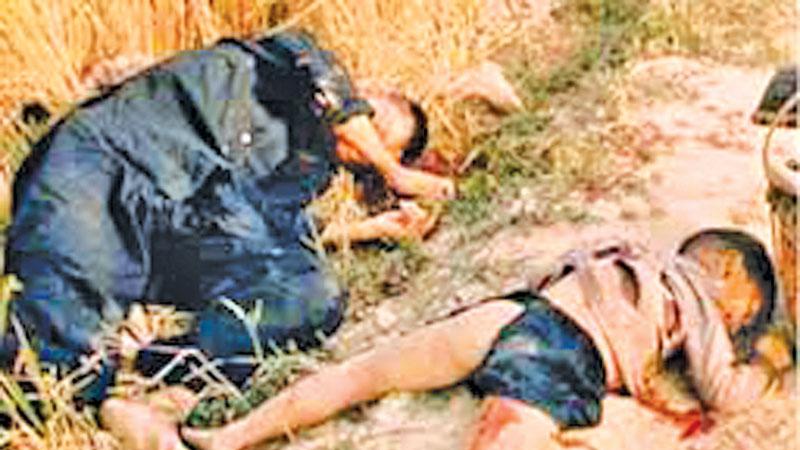
“Lest we forget”, yesterday, March 16th, marked the 51st anniversary of the My Lai massacre, committed by the United States soldiers from Company C, 1st Battalion, 20th Infantry Regiment, during the Vietnam war. “Victims included men, women, children, and Infants. Some of the women were gang-raped and their bodies mutilated, including children as young as 12”.
The harrowing accounts of what happened at My Lai, (let alone the photographs), available on Wikipedia and numerous other independent Internet sources, will turn your stomach – and the photos are unsuitable for children to view. The classic photograph - taken by US Army photographer Ronald L. Haeberle on March 16, 1968, in the aftermath of the Mỹ Lai Massacre shows mostly women and children dead on a road.
What happened
The massacre took place in two Vietnamese villages, marked on American Military maps as Mai Lai and Mai Khe. The village was suspected of harbouring the Viet Cong (Vietnamese resistance fighters). Frank A Barker was the Commanding Officer (he was never even tried for his deeds), Captain (CPT) Ernest Medina, Commanding Officer gave instructions which were later variously interpreted as - “ to kill all North Vietnamese combatants and ‘suspects’ (this included women and children, as well as all animals), burn the village, and pollute the wells”. A witness testified that he remembered Medina ordering –“ destroy everything in the village that was “walking, crawling or growing”.
At about 7:30 a.m., around 100 soldiers from Charlie Company led by CPT Ernest Medina, landed in helicopters at a patchwork of settlements, paddy fields, irrigation ditches and dirt roads.The villagers, who were getting ready for market , initially did not panic or run away, as they were herded into the hamlet’s commons. Harry Stanley, a machine gunner from Charlie Company, said later, that the killings started without warning. He saw fifteen or twenty people, mainly women and children, kneeling around a temple burning incense. They were praying and crying. They were all killed by shots to the head.
Second Lieutenant (2LT) William Calley and a Platoon led by Stephen Brooks entered the hamlet of Tu Cung , where most of the slaughter occurred, at about 8 am. About 70–80 villagers were rounded up, led to an irrigation ditch, pushed in the ditch and killed after repeated orders issued by Lieutenant Calley. PFC Paul Meadlo testified later, that he recollected that women were allegedly saying “No VC” (“No Vietcong here”) and were trying to shield the children. He remembered that he was shooting women with babies in their hands.
When PFC Michael Bernhardt entered the subhamlet of Xom Lang, the massacre was on, and he later testified - “We had no casualties. It was just like any other Vietnamese village – old papa-sans, women and children. As a matter of fact, I don’t remember seeing one military-age male in the entire place”. Around 11 a.m., Captain Medina radioed to ceasefire and the 1st Platoon took a lunch break. (Per Pittsburgh Post Gazette, February 1971).
The 3rd Platoon, dispatched to deal with the “remaining resistance”, also reportedly rounded up and killed a group of seven to twelve women and children. Over the next days, additional burning and destruction of dwellings, and abuse of Vietnamese detainees, took place.
William Thomas Allison, a Professor of Military History at Georgia Southern University, wrote, “By mid morning, members of Charlie Company had killed hundreds of civilians and raped or assaulted countless women and young girls. They encountered no enemy fire and found no weapons in My Lai itself-
The dissenters
Warrant Officer Hugh Thompson Jr, a helicopter pilot saw dead and wounded civilians as he was flying over a village. He landed. He found 12–16 people in a bunker, coaxed them out and led them to safety, standing with them while they were flown out in two groups. He was to later testify against those responsible. For his actions Thompson was awarded the Distinguished Flying Cross.(DFC). As the DFC citation included a fabricated account of rescuing a young girl, Thompson threw his medal away.
General William C. Westmoreland, the Head of Military Assistance Command, Vietnam, congratulated Charlie Company, only to later change his position.
Tom Glen, a 21-year-old soldier of the 11th Light Infantry Brigade, wrote a letter to General Creighton Abrams, the new MACV Commander, in protest.
Later to be Secretary of State and overlook the Invasion of Iraq, Colin Powell, then a 31-year-old was charged with investigating the letter. His response was described a a “whitewash”.
In 1970, Hugh Thompson testified against those responsible for the My Lai Massacre. Twenty-six officers and enlisted soldiers, including William Calley and Ernest Medina, were charged with criminal offences and all were either acquitted or pardoned.
Sources: “Murder in the name of War” BBC News, July 20, 1998; Susan Browmiller (1975)- “Men, Women and Rape ( page 103-105); William Thomas Allison- “An American atrocity in the Vietnam War”
